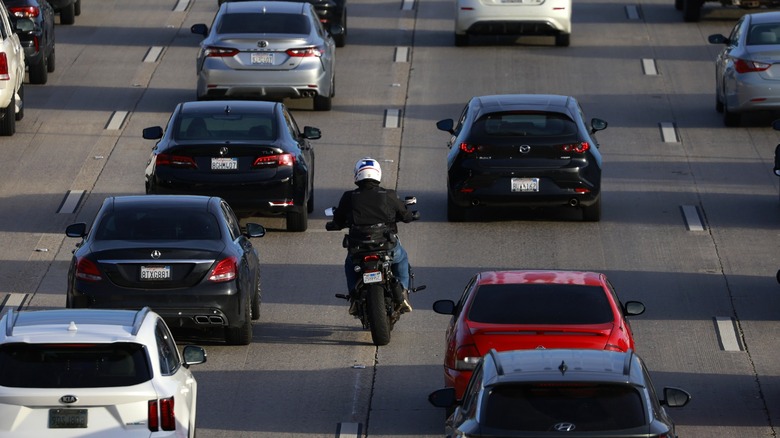
Kevin Carter/Getty
Motorcycle riders love their bikes for myriad reasons. Whether it’s the thrill of tearing down the highway on one of the fastest motorcycles ever built or the convenience of a small, fuel-efficient vehicle that can quickly carry us around the city or town, it’s impossible to deny the innumerable benefits that motorcycles provide. However, not everyone is a fan of motorcycles or the ways drivers maneuver them. One motorcycle benefit, in particular, has been the subject of intense debate, confusion, and misinformation.
Lane splitting is the act of driving between individual lanes of traffic that are moving in the same direction. In other words, when a motorcyclist drives in between two cars traveling northbound on a highway or city street, they’re lane splitting. Riders use the tactic to quickly navigate traffic and get around slower-moving vehicles.
Many proponents of the act claim that it reduces traffic accidents and increases rider safety, but critics, on the other hand, allege that lane splitting is dangerous. The act is illegal in most U.S. states, but there are exceptions. Let’s dive in and take a deeper look at lane splitting and explore the places where it’s legal and illegal.
What is lane splitting?
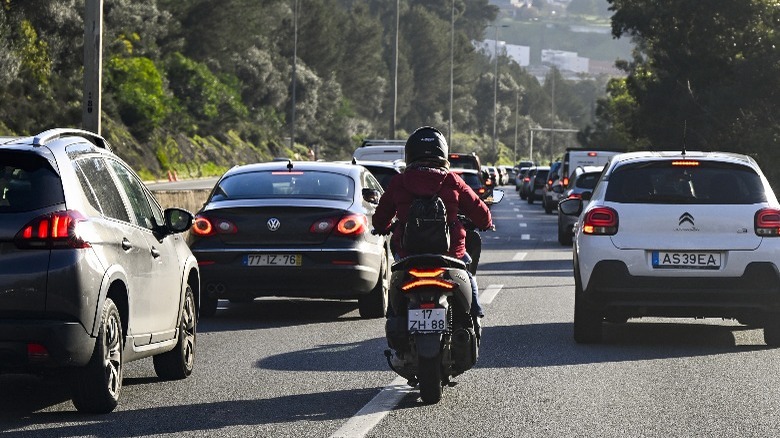
Horacio Villalobos/Getty
As mentioned above, lane splitting occurs when a motorcyclist — or bicyclist — drives in between lanes of traffic with vehicles moving in the same direction. Lane splitting is sometimes referred to as white-lining or stripe-riding because motorcyclists must hug the painted lines that divide individual traffic lanes. It’s a popular tactic in densely populated cities, and it allows riders to circumvent slow-moving traffic and large vehicles.
While the above information covers the official definition of lane splitting, the phrase has become a bit of an umbrella term that may mean different things to different people. One of the most common acts to fall under the lane-splitting umbrella is lane filtering.
Lane filtering is similar to lane splitting in that riders navigate between individual lanes of traffic. However, the difference is that lane filtering refers to the act of driving between stationary or extremely slow-moving vehicles at an intersection. Like lane splitting, lane filtering allows motorcyclists to get around larger vehicles quickly and enables them to cross intersections safely due to their position at the front of the line.
Is lane splitting dangerous?
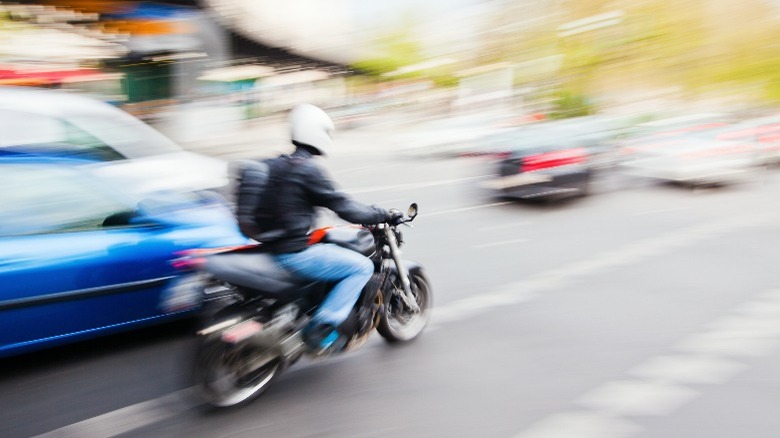
Chris-mueller/Getty
Supporters claim that lane splitting makes the roads safer for everyone involved, and there is some evidence to support this claim. Not only does lane splitting allow riders to reach their destinations more quickly, but it can also prevent accidents in some cases due largely to the fact that motorcyclists who lane split are less likely to be rear-ended by other motorists. While most people don’t think of fender benders as serious accidents, a rear-end collision can be extremely perilous for a motorcycle rider.
Lane splitting is also thought to reduce overall traffic and even contribute to reduced fuel consumption while preventing motorcycle damage. When riders lane split, they take up less space on the road and leave the road more quickly. Furthermore, motorcyclists who lane split spend less time idling in traffic, resulting in less fuel burned and reducing their bikes’ risks of overheating.
Critics of lane splitting, on the other hand, claim that the act is unsafe — for everyone — and unfair for drivers of regular passenger cars. These detractors allege that lane splitting requires motorcyclists to be too close to other vehicles, resulting in decreased reaction times and increased risks of accidents. Finally, many believe it’s unfair for motorcyclists to «skip» other drivers. These drivers believe that everyone on the road should wait their turn and that lane splitting is similar to skipping the line.
Is lane splitting legal in the United States?
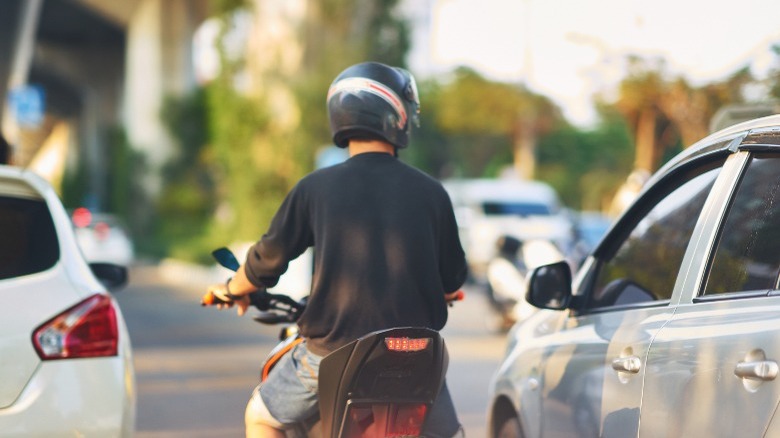
Vach cameraman/Shutterstock
Lane splitting is illegal in most of the United States. The act is legal in California on all roads, but The Golden State does include a few additional guidelines for riders. The state encourages riders to drive no more than 10 mph faster than the cars around them and discourages motorcyclists from lane splitting at speeds greater than 30 mph. It also adds that the safest area for lane splitting is between the far left lane and the lane to its right — or between the left and middle lanes on a three-lane highway. Finally, the California DMV also recommends that riders avoid lane splitting near off- or on-ramps on the interstate.
Outside of California, some states don’t yet have laws regarding lane splitting, but some are starting to establish rules around lane filtering. States like Utah, Arizona, and Montana just recently created laws surrounding lane filtering within the last few years. Within the states that allow lane filtering, the regulations vary.
For example, Hawaii only allows motorcyclists to use the shoulder to go around stopped motorists, and it does not allow riders to drive in between lanes. If you live in one of these states, you should check your local laws to determine the exact guidelines you must follow. Lane splitting is still illegal in much of the U.S., and if you get caught lane splitting in one of these states, the penalties can be harsh.
Is lane splitting legal outside of the United States?
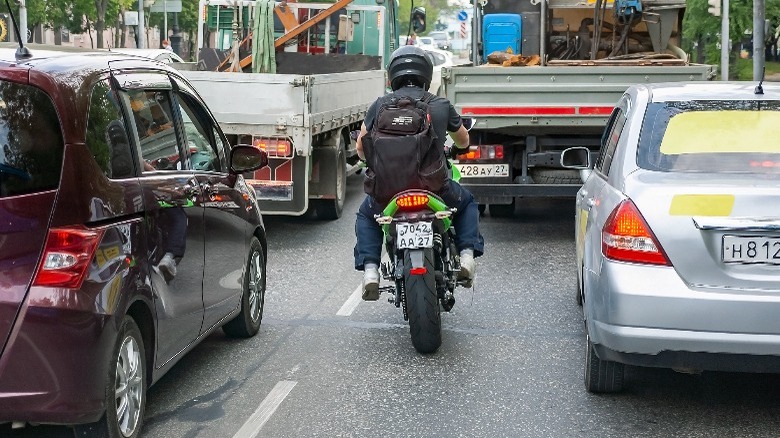
Sergey Watgers/Shutterstock
Lane splitting is legal in many countries outside the United States. Most European nations allow lane splitting to some degree, but there are exceptions. Germany, for example, prohibits lane splitting but allows lane filtering. That said, lane splitting is not only legal but extremely normal in most European countries, and European immigrants routinely express shock and disappointment after arriving in the U.S. and receiving a traffic citation for performing the act.
Lane splitting is also legal and highly common in most developing nations, like Thailand, Indonesia, and Brazil. The practice is accepted in many areas around the world, especially in regions where motorcycles are one of the predominant forms of transportation, like developing countries and densely packed cities. Some of the other countries that allow lane splitting include Mexico, Japan, Greece, Ireland, Singapore, South Africa, Taiwan, and many more.
While it’s incredibly common for lane splitting to be legal or, at the very least, tolerated in countries outside the United States, you should exercise caution if you plan to do it. Always check up on local laws and follow basic motorcycle safety tips to keep yourself and others secure on the road.